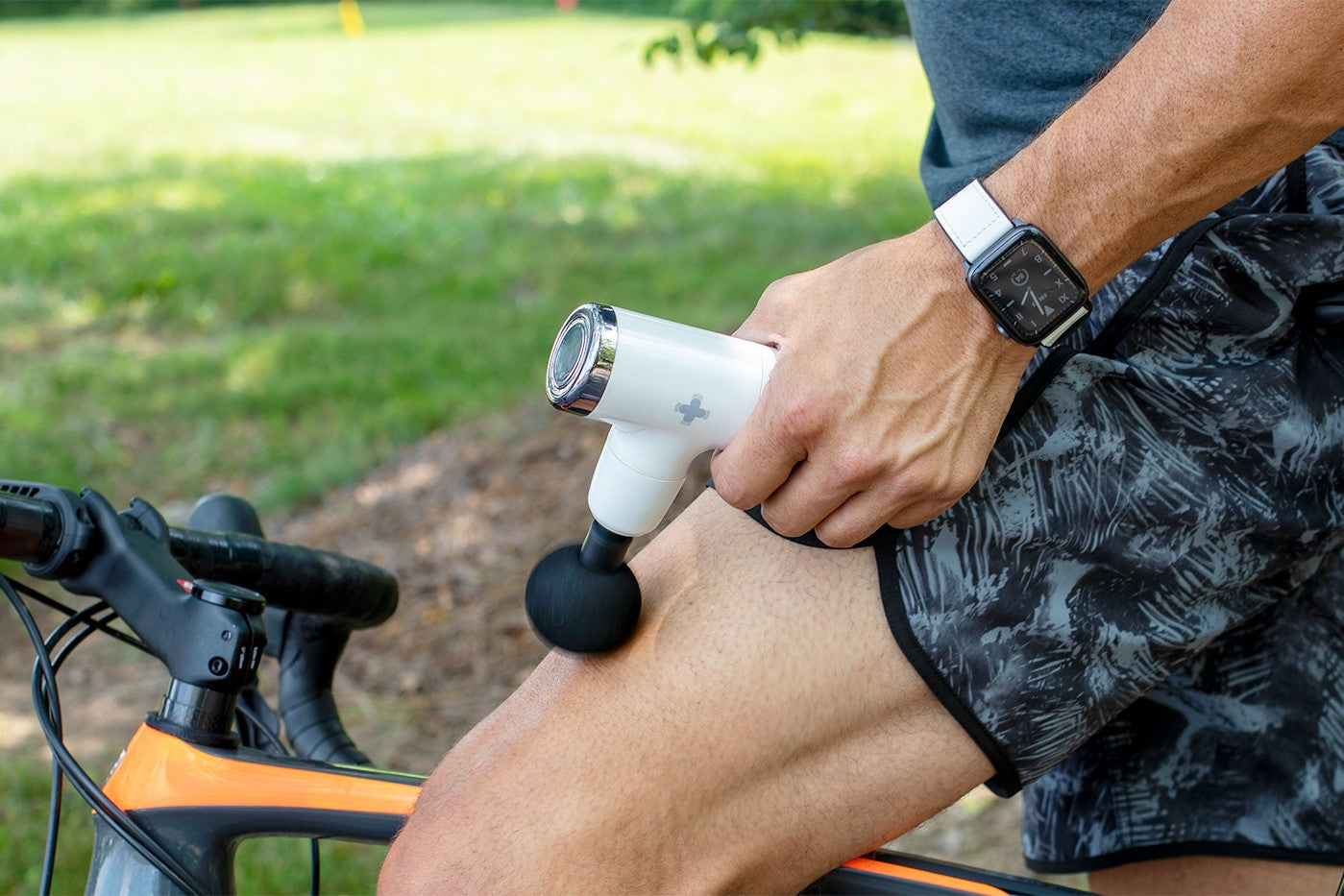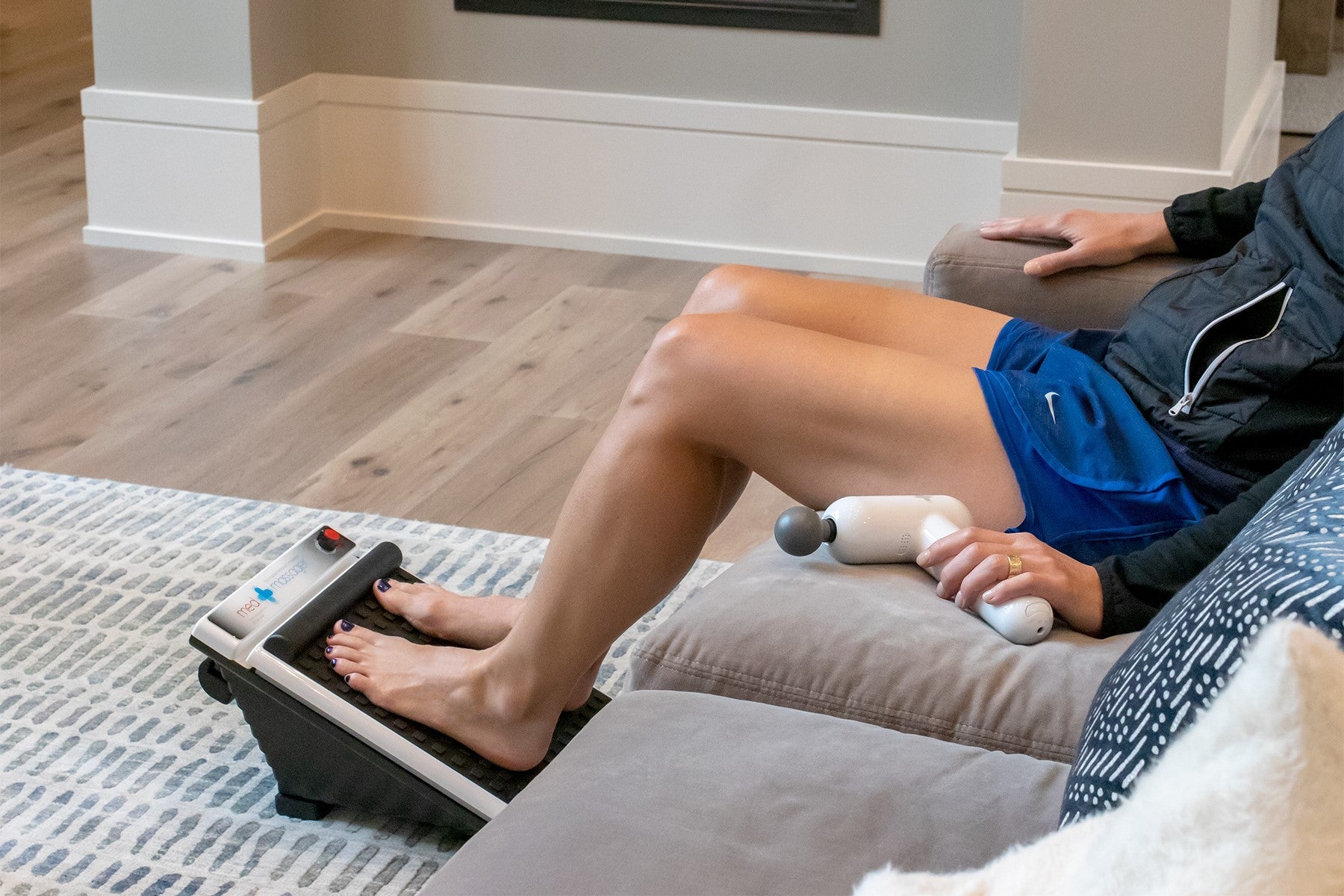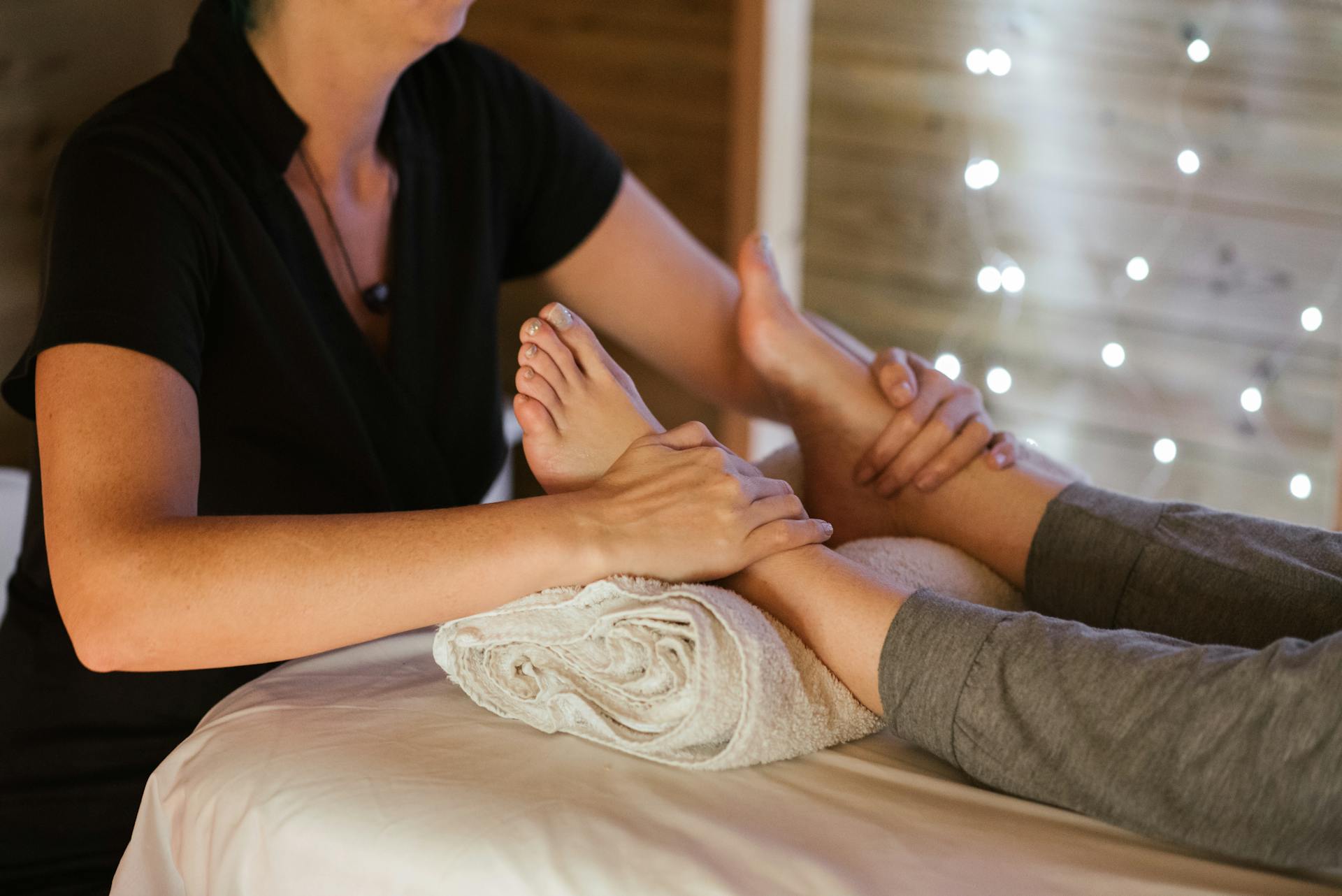Have you ever experienced upper knee pain, stiffness, and swelling after a run through the park or weight-lifting session? If so, you might be familiar with quadriceps tendonitis, an overuse condition that impacts the tendon just above the knee cap.
Quadriceps tendonitis can quickly get in the way of your daily routine, especially if you’re active or always on the move. But here’s some good news: Massage therapy, a popular tool for relieving aches and pains, may come in handy for some people with this condition.
Below, we’ll cover everything you need to know about quadriceps tendonitis massage — including the benefits, how it works, and precautions to know about.
What Is Quadriceps Tendonitis?
The quadriceps tendon (above the knee) and patellar tendon (below the knee) work with your leg muscles to straighten the knee joint. But when the quadriceps tendon suffers tiny micro-tears due to overuse or injury, it can lead to pain and stiffness above the joint.
The Mayo Clinic reports that quadriceps tendonitis usually occurs due to prolonged stress on the tendon. In other words, while it can occur due to a sudden injury, it typically happens after long-term wear and tear.
This pain of quadriceps tendonitis can be short-term, healing in just a few weeks with some simple lifestyle changes. But in some cases, it may last up to several months and require more in-depth care.
Causes of Quadriceps Tendonitis
Some common risk factors that can contribute to quadriceps tendonitis include:
- Muscle imbalances and poor posture
- Incorrect form while working out
- Repetitive strain from weight lifting, running, or playing sports
- Footwear that lacks proper support
- Aging, since tendons can become less flexible as your body gets older
Over time, microtrauma can cause the tendon to build up scar tissue — especially if it’s not given enough time to heal after each injury. And when repetitive stress happens faster than the body can repair itself, that’s when tendonitis can develop.
This is why athletes and people who do the same movements, week after week, tend to be more prone to quadriceps tendonitis than others. But it can affect anyone who’s active, even if you only recently started a new physical activity. And in some cases, it can even affect people who don’t play sports or work out.
Common Treatments
If you end up with a case of quadriceps tendonitis, your doctor may suggest a few simple treatments to get you feeling better. These could include:
- The RICE method is a common treatment for sports-related injuries. It stands for rest, ice, compress, and elevate. When an injured tendon needs time to heal, this is often the best first step to take.
- Physical therapy: In more persistent cases of tendonitis, a physical therapist (PT) can work with you on a customized plan to support your healing. It may include specific exercises, hot and cold therapy, specialized massage, and other techniques.
- Shoe support: For some people, investing in more supportive shoes and insoles can bring some relief to the knee joint.
- Over-the-counter pain medications can help keep inflammation at bay.
In rare cases, patients with quadriceps tendonitis may need surgery to repair the tendon. Fortunately, this doesn’t happen very often — and with some simple at-home care, most people can count on their symptoms subsiding over time.
The Potential Benefits of Quadriceps Tendonitis Massage

So, how can massage therapy help quadriceps tendonitis? Aside from being one of the most popular tools for relaxation and muscle TLC, massage may bring a range of potential benefits for soft tissue injuries like tendonitis.
For example, a gentle massage can help support healthy blood flow and ease pain. Plus, it can break up muscle stiffness and knots that are limiting your ability to move freely. And since many self-massage techniques are easy to try at home, it offers an accessible way to find in-the-moment comfort.
Quadriceps Tendonitis Massage Techniques
With all the benefits in mind, here are a few quadriceps tendonitis massage methods that could bring relief:
It’s important to note that massage can worsen pain and inflammation for some injuries. For this reason, always remember to get your doctor’s OK before starting.
1. Cross Friction Massage
Research has shown that cross friction massage — also called transverse friction massage — may help soothe certain types of tendon-related pain.
This modality often goes hand-in-hand with a physical therapy routine, as it helps to break up the painful effects of scar tissue. And coupled with the right treatment plan, many people find that it brings significant relief.
A PT might recommend you try this technique when your pain is mild, but you’re still noticing some stiffness around the knee. Here’s how it works:
- Sit in a comfortable chair where you can easily access your upper knee area.
- Use your fingers to apply moderate pressure from side to side across the quads, above the knee. This might feel a little tender at first, but it shouldn’t be painful.
- After 15 to 30 seconds, you should notice some relief in the area. (If you feel like it’s making your pain worse, it’s best to stop and wait a few days before trying this technique.)
- Massage for 3 to 5 minutes, or as long as it feels good to you. Repeat up to a few times per day as needed.
2. Massage Gun Quad Massage
Massaging with the delicate muscles in your fingers can certainly get tiring, even after just a few minutes. For this reason, opting for a massage gun can be a great choice when you want an easy, targeted massage at home.
Massage guns use powerful bursts of pressure known as percussive therapy to work into the muscles. They can be pretty intense, so it’s important to use them with caution, and pay attention to your body’s signals along the way.
With these tips in mind, here’s how you can use a massage gun on sore, stiff quadriceps muscles:
- Attach the soft, round ball attachment to the massage gun.
- Set the device to your desired setting. (If you’re not sure which pressure level to try, it’s always best to start low and slow and increase as needed.)
- Hold the massage gun at an angle and glide it side-to-side across the top of the quads (similar to the cross friction technique covered above) for 1 to 2 minutes.
Note: Stick to the muscles while you massage, and avoid placing the massage gun directly on any bony areas.
3. Foam Roll Quad Massage
Another quadriceps tendonitis massage option is foam rolling — a simple form of sustained, gentle massage that’s easy to use at home.
Now, it’s important to avoid foam rolling if you have a fresh, acute injury. But if you’re noticing some long-term stiffness, a simple rolling session can help you break up tension that might be interfering with your daily movement.
Here’s how to do it:
- Find a soft surface to roll on, such as a yoga mat.
- Place the foam roller out in front of you.
- Face toward the floor and slowly lower your affected quad onto the roller. Use your arms and opposite leg to help support your body weight.
- Mindfully roll forward and backward with light-to-moderate pressure for a total of 1 to 2 minutes.
4. Massage Ball for Trigger Points in Quads
While many people think that knots (or trigger points) are only found in the back or between the shoulder blades, the quads are also a common hotspot for them.
Fortunately, a large massage ball can help you target and roll out these achy bands of muscle, ultimately helping to relieve some tension around the knee.
Here’s how:
- Place the ball under your affected quad muscle, and lower your body toward the ground.
- Lean on your elbows and opposite leg to support your weight. Then, slowly roll back, forth, and side-to-side to massage the leg.
- When you roll over a knot, simply hold the pressure over it for a few extra seconds.
- Repeat for 2 to 3 minutes.
5. Professional Massage
If you want a comprehensive massage experience from an expert, visiting a spa or massage therapist’s office is the way to go.
When scheduling an appointment, it’s also a good idea to ask for a masseuse who has experience working with tendonitis. This way, they’ll be familiar with the precautions, proper techniques, and modalities that tend to be most soothing.
Once you arrive, your masseuse will spend a few minutes talking with you about which massage styles may be best for you. Here are some of the most popular options, along with what to expect from each:
Deep Tissue Massage
Deep tissue massage involves deep, targeted pressure to ease pain points throughout the body. If you opt for this style, your masseuse will use friction, direct pressure, and slow, deep movement to break up adhesions and support your flexibility.
This type of massage isn’t for everyone, since it normally comes with a bit of discomfort and is less relaxing than more traditional options. Nonetheless, many people find that it’s helpful for chronic overuse injuries like quadriceps tendonitis.
Sports Massage
Like deep tissue massage, sports massage therapy often uses deep pressure. However, it tends to be more targeted toward specific muscle groups and problem areas. And sometimes, it may also involve stretching.
It’s a popular style among athletes and highly active people who want to soothe pain, improve range of motion, and prevent future injury.
Trigger Point Therapy
Trigger point therapy is a technique that can be added to nearly any professional massage session. This technique aims to break up muscle knots and adhesions by applying cycles of sustained pressure.
Swedish Massage
If you’re ready to try massage, but want to get a feel for the pressure level that’s right for you, the Swedish style is a great place to start.
In a Swedish massage session, a masseuse will use a mix of gliding, kneading, tapping, and vibration to promote relaxation and well-being throughout the body. Overall, it’s one of the gentlest approaches to massage that you can try.
Massage Precautions: When to Talk to Your Doctor
With certain medical conditions, putting pressure on specific areas (or the body as a whole) can come with some adverse effects. For example, you’d want to exercise caution if:
- You are pregnant. Those who are pregnant (or suspect they might be) should check with a doctor before trying massage therapy. If you get the OK, be sure to work with a certified prenatal massage therapist.
- You have a blood clotting disorder. Since massage may affect blood flow, it’s not recommended for people with conditions that increase the risk of blood clots.
- You have a skin condition that may become irritated by massage.
- You have any other conditions that haven't been OK’d for massage in the past. These may include uncontrolled high blood pressure, diabetes, infections, osteoporosis, kidney conditions, cancer, etc.
For the most part, massage is a relaxing and soothing experience — but everyone’s health is unique, and it’s important to stay safe. If you have any uncertainties, be sure to give your healthcare team a call before getting started.
Other Tools and Remedies for Quadriceps Tendonitis
When you have quadriceps tendonitis, supporting your body’s healing process is key. And the good news is that plenty of tools and remedies can help you do this.
Some steps you can take include:
Prioritizing Your Rest
With any type of tendonitis, rest is essential. Because this condition is most often a result of overuse, any extra movement in the early stages can put unnecessary stress on the injury.
So, be sure to take a few days to give your leg some TLC. Relax, elevate it if needed, and be gentle with your movements until the pain starts to ease up.
Modifying Your Activities
When you have quadriceps tendonitis, modifying your daily activities can help you cut out the strain where it started.
For example, if you were using incorrect form while lifting weights — or simply lifting too heavy — you can adjust your routine to make it easier on your knees. Or, if you normally run on hard pavement, you could consider switching your running trail over to a soft, grassy area.
Although changes like these are simple, they can be powerful when it comes to relieving and preventing tendonitis pain.
Give Heat or Cold Therapy a Try
When you’re struggling with quadriceps tendonitis, both heat and cold can be helpful remedies to try.
Cold is often your best bet when dealing with acute, recent tendon pain (perhaps that resulted from a sudden injury). On the other hand, heat tends to bring more relief when you’re dealing with long-term stiffness and achiness.
Try Specific Exercises
If you decide to visit a physical therapist for your quadriceps tendonitis, they may recommend specific exercises to strengthen your legs, correct imbalances, and help your body function better as a whole.
These may include:
- Targeted stretches to improve mobility and muscle function
- Isometric strengthening exercises to isolate the quads, such as static quad contractions
- Eccentric exercises to strengthen the knee region, such as lightweight leg extensions
Invest in Supportive Knee Wear
For some people, using supportive knee wear — such as a knee sleeve or neoprene knee brace — can help ease the symptoms of quadriceps tendonitis.
Knee sleeves offer light support and compression, and are designed to fit comfortably under clothing. Knee braces, on the other hand, are better when you need more heavy-duty support to protect the joint from future injury.
Quadriceps Tendonitis Massage: The Takeaway
Massage may not be a cure-all for quadriceps tendonitis — but for many people, it can certainly bring some in-the-moment relief.
The right pressure and techniques can promote healthy blood flow, support flexibility, and ease pain near the quads. And coupled with a solid home treatment plan, a good massage routine could play a key role in helping you manage pain and get back to moving normally.
Finally, be sure to talk with a healthcare professional if your pain is severe or has been lingering for more than a few weeks. With their help, you can choose the right tools to support your body’s healing process — whether that means physical therapy, massage, activity modification, or a combination of treatments.
For Regular, Restorative Massage at Home
If you’re ready to make massage a long-term part of your recovery routine, the tools from MedMassager can help.
Learn about the MedMassager Accuvibe Mini massage gun today, or explore the full line of restorative tools here.



